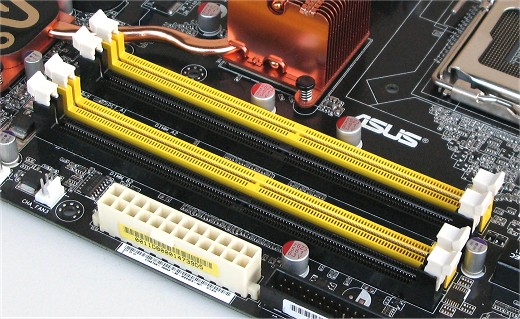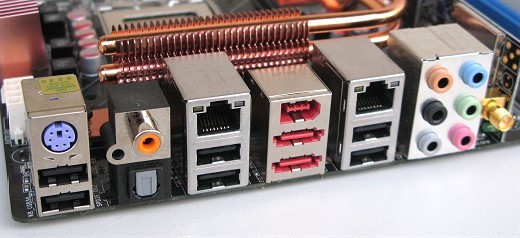Board Layout & Features
ASUS began using heatpipes to cool their motherboards back in 2005 with the A8N32-SLI Deluxe motherboard. Heatpipes are ideal for motherboards as these large component boards generally have multiple components generating large volumes of heat. The north and south bridge chips generate quite a lot of heat on their own, while the numerous MOSFET chips also contribute with a significant amount of heat. Combined with the large amount of power now required by these, motherboard manufacturers started to have serious trouble.
 |
Simply placing a heatsink over each component with some form of active cooling wouldn't create satisfactory results. Fans create noise, sometimes a little too much and this has become yet another concern for users. Heatpipes on the other hand can be used to evenly distribute heat across several components, moving it away from hot spots and allowing the parts that receive more air-flow to help remove excess heat from other components.
The ASUS P5K Deluxe uses a number of heatpipes used to connect three series of heatsinks. This setup does work quite well, though we still have concerns for the south bridge. The small heatsink placed over this chip often reached over 45 degrees under normal operation and was burning hot to touch. The single heatpipe was not moving heat away from this component effectively enough when the board was lying flat. On its side as it would be positioned in an ATX case, the temperatures did fall, but only by a few degrees, leaving us a little concerned.
 |
As mentioned earlier the ASUS P5K Deluxe only supports DDR2 memory via four DIMM slots designed to accept up to 8GBs of non-ECC, unbuffered memory. This dual-channel setup can operate at 667MHz and 800MHz, while ASUS has included unofficial DDR2-1066 memory support as well. The BIOS also includes an extensive range of memory options that can be tweaked to improve performance. ASUS claims that this board includes their "Super Memspeed Technology" which enhances memory speed by up to 75%. This is an interesting claim which we saw no evidence of, despite the box being plastered with this statement.
 |
The 8-phase power design featured on the ASUS P5K Deluxe is important as this ensures a constant flow of power to the processor. This efficient circuitry should help users reach greater numbers when overclocking. Furthermore, an 8-phase power design can also allow the Core 2 Duo processor to operate at a lesser temperature than it would on a board using a 3 or 4-phase design.
 |
The blue slot above is where the serious stuff ends and the gaming begins. This blue PCI Express 16x slot allows gamers to configure their P5K Deluxe with any number of compatible graphics cards, including the GeForce 8800 Ultra and the Radeon HD 2900XT. Those fond of multi-GPU technology can also use two Radeon-based graphics cards in Crossfire mode on this motherboard. The second black PCIe 16x slot can be used to host an additional Radeon graphics card and although it only works at 4x speeds, there shouldn't be a noticeable loss in performance.
 |
As you can see, the I/O panel of the P5K Deluxe means business with a total of twenty-one different connections. There are six USB 2.0 ports in total, with a single Firewire port and two eSATA ports. There are eight audio connections: six audio jacks, a coaxial, and an optical S/PDIF port. There is just one PS/2 port for a keyboard, while the mouse PS/2 port has been removed and replaced with two USB ports which seem to be a good trade off.
Overall the board design is exceptional, with no real flaws to speak of and the feature set looks to be impressive. While the cooling design is adequate and surpasses that of most motherboards, we would have liked the south bridge chip to operate considerably cooler than it does. The inclusion of just one PCI 1x slot is also a little disappointing.
The eSATA ports on the I/O panel are handy, but we prefer them not to be placed here, rather conventional on-board SATA ports are better. Including eSATA brackets are a better option as users can select whether or not they wish to use them. Rear positioned eSATA ports would become near useless if the case was placed under a desk for example. For this reason front mounted eSATA ports offered by some cases are usually a much better approach. Other than this the design is excellent, which has made working with the P5K Deluxe a pleasure.